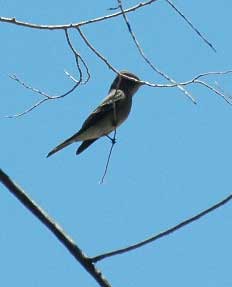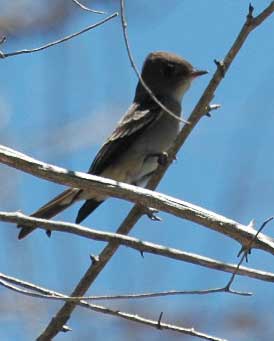If you hear the characteristic song of the Wilow flycatcher, a low buzzy "fitz!-bew" or rough "wie-viel", you are home-free with identifying this little Empidonax. If it is calling a soft "wit", other species also give this call. To identify these flycatchers look for a long, wide bill with an entirely yellow-orange lower mandible. The head appears large and is often peaked, brownish-olive in color. The throat and often the lower parts are yellowish, with a pale olive upper breast. There is no eyering, or it is very faint (Stephen Bailey, personal communication 1983).

Wing tips appear medium-long as the bird perches. It often flicks its tail up.
Willow flycatchers are fairly common migrants through Oasis Valley in May-June and August-September. They prefer cottonwoods, willows, and other trees for foraging, often on edges of groves.
Willow flycatchers may possibly breed in Oasis Valley riparian areas, although cattle grazing that disturbs or removes the lower thickets and undergowth has eliminates much good habitat. They favor shrubby willow riparian and wet meadow areas that receive flooding or are near water. The federally protected Southwestern flycatcher (Empidonax trailli extimus) has been recorded in southern Nevada Mojave desert wetlands. The Great Basin form (E. t. brewsteri) breeds in a few places in northern Nevada, and migrants have been found in our region, in nearby Death Valley National Park (Birds of Death Valley National Monument by Roland Wauer, 1962, unpublished manuscript in Death Valley National Park library).
HOME..........Oasis Valley Birds..........Oasis Valley Bird List

